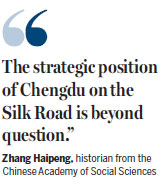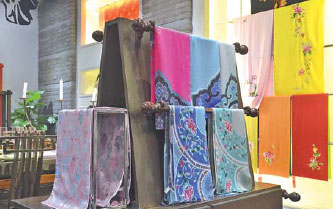Silk products'spread offers clues to ancient trade relations
On April 8, the Academic Seminar on the Land of Abundance and the Silk Road was held in Chengdu. Experts attending the meeting said the city has not only provided quality silk products for countries along the Silk Road, but also offered refined craftsmen's skills and spirit.
Zhang Haipeng, a historian from the Chinese Academy of Social Sciences, said: "Sichuan province was the main production base of silk on the Silk Road. The strategic position of Chengdu on the Silk Road is beyond question."
Sichuan tapestry reflected a high level of technique and ranked first among the top three tapestry traditions in China at the time, Zhang said.
Sichuan brocade has had a huge influence on the development and prosperity of the Chinese brocade industry. Sichuan brocade is therefore dubbed "mother of all brocades".
Duan Yu, professor from the Center for Bashu Cultural Studies of Sichuan Normal University, said the Qin Dynasty (221-206 BC) constructed a silk production base in Chengdu. During the Three Kingdoms Period (220-280), the main income of the government came from tapestry production and trading in Sichuan province.

Four wooden weaving machine models and 14 painted wooden textile craftsmen were unearthed in Tianhui town, Chengdu, in early April. The products represented the top level of spinning and weaving at that time, said Duan.
The local style of tapestry and embroidery were taken to Europe and southern, northern and central Asia, Duan said.
Sichuan embroidery is one of the four most famous embroidery styles of China. In ancient times, Sichuan embroidery and Sichuan brocade were both named "treasures of Sichuan". Now they are both national-level intangible cultural heritage items.
Chinese silk was also unearthed around the Altai Mountains in Russia with patterns of coin trees. The pattern was commonly seen on the plain areas of Sichuan during the Qin and Han dynasties (221 BC-AD 220), he said.
Sun Hua, a professor at the School of Archaeology and Museology of Peking University, said: "Sichuan province, circled by mountains, seemed to be closed off. However, an ancient track opened as early as in the Warring States Period (475-221 BC), to connect the area with other parts of China and the wider world. Part of the track actually overlapped with the Northern Silk Road."
Wang Binghua, a former professor at the School of Chinese Classics of Renmin University of China, said he once found a silk product unearthed in Xinjiang Uygur autonomous region embroidered with "Made in Chengdu".
The seminar was held by six parties, including the Association of Chinese Historians, Society for Chinese Archaeology and School of Archaeology and Museology of Peking University, on April 8.
More than 90 domestic and overseas scholars attended the seminar from Chinese universities and research centers of foreign countries, such as the United States, Sweden, Nepal and Sri Lanka.
|
Sichuan brocade has had a huge influence on the development and prosperity of the Chinese brocade industry. Provided To China Daily |
(China Daily 05/14/2017 page18)






















